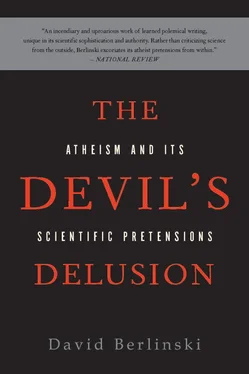If their content is negligible, the influence of these stories is immense. Commenting on negative advertising in political campaigns, Kathleen Hall Jamieson, the director of the Annenberg Public Policy Center at the University of Pennsylvania, remarked that “there appears to be something hardwired into humans that gives special attention to negative information.” There followed what is by now a characteristic note: “I think it’s evolutionary biology.” The fact that there is nothing hardwired about human beings, because they are not wired at all, is passed over as incidental. The metaphor has taken on a life all its own, and now that it is living, it has grown great.
Having provided an explanation of negative campaign advertisements, evolutionary biology also explains war and male aggression, the human sensitivity to beauty, gossip, a preference for suburban landscapes, love, altruism, marriage, jealousy, adultery, road rage, religious belief, fear of snakes, disgust, night sweats, infanticide, and the fact that parents are often fond of their children. The idea that human behavior is “the product of evolution,” as the Washington Post puts the matter, is now more than a theory, it is a popular conviction. The conviction is so popular that it may even be impudently opposed to the regnant conventions of political correctness. The result is an inspiring clash of clichés. In an article published in Psychology Today, Alan S. Miller and Satoshi Kanazawa describe what they consider ten politically incorrect truths about human nature. They regard these truths as discoveries, and in recounting the first item on their list report with an explorer’s sense of satisfied astonishment— Would you look at that? —that “men like blonde bombshells.” If this is a truth about human nature, it has not been especially well hidden.
Nor does it seem to cry out for any explanation beyond the obvious. Men like blonde bombshells because they are blonde bombshells. I would even go further. Men seem to like bombshells no matter the color of their hair.
What more is really needed?
For Miller and Kanazawa, the demands of science are more considerable. What they require is an explanation beyond the obvious. Aussitôt dit, aussitôt fait, as the French say. No sooner said than done. Our ancestors millions of years ago, they assert, were evidently concerned to discover fine, healthy women, and lacking suitable gynecological skills, necessity compelled them to pay attention to their secondary sexual characteristics. Whence the popularity of blonde bombshells. The subject has been the focus of research extending over decades, psychologists investigating the extent to which blonde bombshells are bombshells with never-flagging zeal and, in some cases, even conducting their research in various strip clubs the better to establish that various bombshells really are blonde.
Unneeded as an irrelevance, these ideas are implausible as an explanation. If sexual preferences are rooted in the late Paleolithic era, men worldwide should now be looking for stout muscular women with broad backs, sturdy legs, a high threshold to pain, and a welcome eagerness to resume foraging directly after parturition. It has not been widely documented that they do.
Our ancestors are in any case unavailable. Claims made on their behalf are unverifiable. The underlying tissue that connects the late Paleolithic and the modern era is the gene pool. Changes to that pool reflect a dynamic process in which genes undergo change, duplicate themselves, surge into the future or shuffle off, and by means of all the contingencies of life serve in each generation the purpose of creating yet another generation. It is precisely these initial conditions that popular accounts of human evolution cannot supply. We can say of those hunters and gatherers only that they hunted and they gathered, and we can say this only because it seems obvious that there was nothing else for them to do. The gene pool that they embodied cannot be recovered.
The largest story told by evolutionary psychology is therefore anecdotal. It has no scientific value.
We might as well be honest with one another. It has no value whatsoever.
It was just yesterday that Freud depicted the human mind as a fabulous haunted house. The image has had an enduring value, if only because on some level we are all haunted by things we cannot name and do not recognize. The analytical deficiencies of Freudian theory are nonetheless considerable, for if the Freudian house was haunted, Freud was unable to say who haunted it. Items such as the id, the ego, and the superego functioned as characters in Freud’s system. They had needs, they made their demands known, they were artful in concealment; and these are among the attributes of the human mind for which an explanation was originally needed.
The haunted house has given way in our time to the digital computer. The argument proceeds in steps. The first involves the dismissal of the mind as a separate ontological category. Mind and brain, as Descartes supposed? This is Cartesian dualism and widely rejected by philosophers. “Every aspect of thought and emotion is,” Steven Pinker has argued in How the Mind Works, “rooted in brain structure and function.” This tells us where the mind is by telling us where it has gone to. It has been swallowed up by the brain. If one needs directions, it suffices to tap significantly at one’s skull:
Tap One: The mind is the brain.
How a craving for raspberry Jell-O might be located within the human brain, Pinker does not say. Perhaps it involves neurons devoted to gelatin? I am asking in a spirit of honest inquiry.
With the mind removed, it remains for Pinker to explain how the brain undertakes so many activities formerly undertaken by the mind. As it happens, this is not a problem either. It is the brain’s capacity to process information, Pinker believes, that “allows human beings to see, think, feel, choose and act.” The digital computer is precisely a device designed to process information. Whereupon we discover how the mind works. The same significant tap may be invoked for a second time.
Tap Two: The brain is a computer.
Between Tap One and Tap Two, the mind has been demoted (No such thing) and explained (No such thing is a computer).
Whatever one might say about Steven Pinker’s thoughts about the human mind, they do not lack for dramatic vigor.
In 1936, the British logician Alan Turing published the first of his papers on computability. Using nothing more than ink, paper, and the resources of mathematical logic, Turing managed to create an imaginary machine, one capable of incarnating a very smooth, very suave imitation of the human mind.
Known now as a Turing machine, the device has at its disposal a tape divided into squares, and a reading head mounted over the tape. It has, as well, a finite number of physical symbols. The reading head may occupy one of a finite number of distinct physical states.
And thereafter the repertoire of its action is extremely limited. A Turing machine can, in the first place, recognize symbols, one square at a time. It can, in the second place, print symbols or erase them from the square it is scanning. And it can, in the third place, change its internal state, and move to the left or to the right of the square it is scanning, one square at a time.
There is no fourth place. Without a program a Turing machine can do nothing else. In fact, considered simply as a mechanism, a Turing machine can do nothing whatsoever, the thing existing in that peculiar world—my own, of course—in which everything is possible but nothing gets done.
Читать дальше













